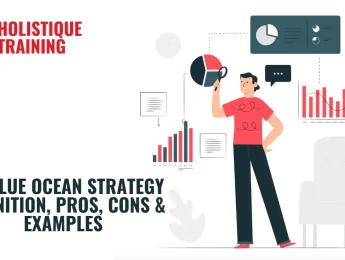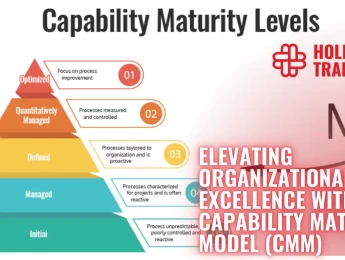- Table of Contents
- Introduction
- What is the Blue Ocean Strategy in Business?
- Definition and Origin
- How It Works
- Difference Between Red Oceans and Blue Oceans
- Red Oceans
- Blue Oceans
- Why is the Blue Ocean Strategy Important?
- Creating New Demand
- Sustainable Growth
- Reduced Competitive Pressure
- Enhanced Brand Equity
- Improved Value Proposition
- Encourages Innovation
- Strategic Flexibility
- Higher Profit Margins
- Focus on Value Creation
- Strategic Alignment and Clarity
- Steps to Implement a Blue Ocean Strategy
- Step 1: Reconstruct Market Boundaries
- Step 2: Focus on Value Innovation
- Step 3: Reach Beyond Existing Demand
- Step 4: Get the Strategic Sequence Right
- Step 5: Overcome Key Organisational Hurdles
- Step 6: Build Execution into Strategy
- Cons of the Blue Ocean Strategy
- High Risk of Imitation
- Initial Investment and Uncertainty
- Market Acceptance and Adoption
- Execution Challenges
- Sustainability of Competitive Advantage
- Operational Risks
- Limited Market Scope
- Strategic Focus and Resource Allocation
- Examples of Blue Ocean Strategy
- Cirque du Soleil
- Nintendo Wii
- Yellow Tail Wine
- Apple iTunes
- Southwest Airlines
- Conclusion
Introduction
Navigating modern business's complex and competitive landscape requires more than incremental improvements and cost-cutting measures. Companies must think beyond traditional market boundaries and seek innovative ways to achieve sustainable growth. Enter the Blue Ocean Strategy, a transformative approach that encourages businesses to explore uncharted waters and create new markets, making competition irrelevant. The Blue Ocean Strategy offers a pathway to unparalleled success and growth by focusing on value innovation and unmet customer needs. This blog post delves into the core principles of the Blue Ocean Strategy, highlighting its significance, implementation steps, potential drawbacks, and real-world examples of its successful application.
What is the Blue Ocean Strategy in Business?
Definition and Origin
The Blue Ocean Strategy is a business methodology that advocates the creation of new market spaces, or "blue oceans," rather than competing in overcrowded existing markets or "red oceans." Developed by W. Chan Kim and Renée Mauborgne, professors at INSEAD, the concept was introduced in their groundbreaking book "Blue Ocean Strategy," published in 2005. The strategy emphasises value innovation, aiming to simultaneously pursue differentiation and low cost to open up new market space and create new demand.
How It Works
Implementing a Blue Ocean Strategy involves identifying and seizing new opportunities without competition. This requires a shift in thinking from a competitive mindset to one focused on innovation and value creation. Companies following this strategy analyse current and potential customers' pain points and unmet needs to develop unique products or services. By doing so, they avoid direct competition and can often command a premium price while keeping costs low.
Difference Between Red Oceans and Blue Oceans
Understanding the fundamental differences between red oceans and blue oceans is crucial for grasping the essence of the Blue Ocean Strategy. These distinctions highlight why pursuing blue oceans can lead to innovative breakthroughs and sustainable growth, while competing in red oceans often results in diminishing returns and intensified rivalry.
Red Oceans
Red oceans symbolise the known market space where industries operate today. Companies vie for market share within established boundaries, and the competition rules are well-defined. The metaphor of "red oceans" comes from the bloodshed of fierce competition, where businesses fight tooth and nail to outperform each other. Key characteristics of red oceans include:
- Intense Competition: Companies in red oceans compete directly, striving to outperform rivals by differentiating their offerings or lowering prices. This often leads to a zero-sum game, where one company's gain is another's loss.
- Market Saturation: As industries mature, markets become increasingly saturated. The pool of potential customers shrinks, making it difficult for companies to find new avenues for growth. Innovation tends to be incremental, focusing on improving existing products and services.
- Commodity Products: In red oceans, products and services often become commodities. With little differentiation, customers make purchasing decisions based primarily on price. This commoditisation pressures companies to engage in price wars, further eroding profit margins.
- Limited Profit Potential: Due to intense competition and market saturation, the profit potential in red oceans is constrained. Companies must constantly battle to maintain or increase their market share, often at the expense of profitability.
Blue Oceans
In contrast, blue oceans represent the untapped market space, the unknown industries not yet existing. These markets are characterised by innovation and the creation of new demand. The term "blue oceans" evokes the image of clear, calm waters, free from the turmoil of competition. Key characteristics of blue oceans include:
- Uncontested Market Space: Blue oceans are defined by the absence of competition. Companies create new demand by offering unique value propositions that meet unmet or latent needs. This uncontested market space allows for more significant growth opportunities and less competitive pressure.
- Market Creation: Rather than competing for a share of existing demand, companies in blue oceans focus on creating new demand. This involves understanding the pain points and desires of non-customers and developing innovative solutions to attract them.
- Value Innovation: Blue ocean strategies emphasise value innovation, which is the simultaneous pursuit of differentiation and low cost. By offering superior value at a lower cost, companies can attract a broad range of customers, including those previously untapped by the industry.
- High-Profit Potential: The lack of direct competition in blue oceans allows companies to achieve higher profit margins. With a unique value proposition, businesses can command premium prices and reduce costs through innovative approaches, leading to sustainable profitability.
Why is the Blue Ocean Strategy Important?
The Blue Ocean Strategy is a transformative approach in business, offering numerous benefits that traditional competitive strategies often fail to provide. Here are some of the key reasons why the Blue Ocean Strategy is important:
Creating New Demand
One of the most significant advantages of the Blue Ocean Strategy is its potential to create new demand. By venturing into uncharted territories and addressing unmet needs or latent demand, companies can attract a broad range of customers previously not engaged by the industry. This expansion of the market base can lead to substantial growth opportunities. Instead of fighting over a fixed pie, companies bake a larger pie by tapping into new segments, thus driving business growth and innovation.
Sustainable Growth
In blue oceans, competition is minimal or nonexistent, allowing companies to enjoy the benefits of a newly created market space. This often translates to higher profit margins and sustainable growth. The focus on value innovation ensures that companies continue to offer superior value, maintaining their competitive edge over time. This approach mitigates the risks of market saturation and allows businesses to maintain long-term success and profitability without constant competitive pressure.
Reduced Competitive Pressure
By venturing into uncharted territories, companies can avoid the intense competitive pressures of red oceans. This leads to a more conducive environment for innovation and reduces the risks associated with price wars and market saturation. Companies can operate with greater strategic freedom and flexibility, focusing on creating value rather than constantly defending their market position. This strategic freedom allows for more innovative thinking and bolder moves that can redefine industries.
Enhanced Brand Equity
Creating a blue ocean often results in pioneering products or services that redefine market standards. This can significantly enhance a company's brand equity, positioning it as a leader and innovator in the industry. The unique value propositions offered by Blue Ocean's strategies resonate well with customers, fostering strong brand loyalty. A strong brand built on innovation and unique value can command premium pricing and enjoy a loyal customer base, contributing to long-term profitability and market leadership.
Improved Value Proposition
The Blue Ocean Strategy focuses on breaking the differentiation and low-cost trade-offs. By offering a unique combination of both, companies can attract new customers who previously did not see value in the existing offerings. This improved value proposition enhances customer satisfaction and loyalty, leading to repeat business and positive word-of-mouth. Customers receive greater value, which translates into higher satisfaction and a stronger competitive position for the company.
Encourages Innovation
The pursuit of blue oceans inherently drives companies towards innovation. By seeking to create new market spaces, businesses are compelled to think creatively and develop groundbreaking products or services. This culture of innovation not only sets companies apart from their competitors but fosters a dynamic and forward-thinking organisational environment. An innovative culture can lead to continuous improvement, employee engagement, and a proactive approach to market changes and opportunities.
Strategic Flexibility
The Blue Ocean Strategy allows companies to redefine market boundaries and explore new avenues for growth. This strategic flexibility allows businesses to adapt to changing market conditions and customer preferences, ensuring long-term relevance and success. In a rapidly evolving business landscape, pivoting and exploring new opportunities is a crucial competitive advantage. This adaptability ensures that companies can respond effectively to external shocks and remain resilient in the face of market disruptions.
Higher Profit Margins
Operating in a blue ocean can lead to higher profit margins, as the competitive pricing pressures of red oceans do not constrain companies. Innovative approaches enhance profitability by allowing companies to offer unique value propositions at premium prices and lower costs. Companies can enjoy the benefits of both increased revenue from higher prices and reduced costs from streamlined operations. This dual advantage contributes to healthier financial performance and greater financial stability.
Focus on Value Creation
The core of the Blue Ocean Strategy is value innovation, which aligns utility, price, and cost positions to create new demand. This focus on value creation ensures that companies deliver products and services that meet customer needs, driving higher customer satisfaction and loyalty. By prioritising value creation, businesses can differentiate themselves from competitors and build a strong, loyal customer base. This customer-centric approach fosters long-term relationships and repeat business, which are essential for sustained success.
Strategic Alignment and Clarity
Implementing a Blue Ocean Strategy requires a clear strategic vision and alignment across the organisation. This strategic clarity helps mobilise resources, foster collaboration, and ensure all efforts are directed towards a common goal. Such alignment enhances efficiency, reduces internal conflicts, and creates a cohesive approach to market opportunities. With everyone in the organisation working towards a shared vision, the execution of the strategy becomes more effective and impactful.
In short, the Blue Ocean Strategy offers a powerful framework for businesses to achieve sustainable growth, enhanced profitability, and long-term success. By focusing on creating new demand, reducing competitive pressures, and fostering innovation, companies can navigate uncharted waters and unlock significant opportunities for value creation.
Steps to Implement a Blue Ocean Strategy
Implementing a Blue Ocean Strategy requires a systematic approach that challenges conventional thinking and encourages innovative solutions. Here are the key steps to effectively implement a Blue Ocean Strategy:
Step 1: Reconstruct Market Boundaries
The first step in implementing a Blue Ocean Strategy is to challenge existing market boundaries and redefine the competitive landscape. This involves looking across alternative industries, strategic groups, buyer groups, complementary product and service offerings, and even across time. By exploring these dimensions, companies can identify new market spaces that have been overlooked or underserved. This process of market reconstruction enables businesses to uncover opportunities for creating uncontested market space.
Step 2: Focus on Value Innovation
Value innovation lies at the heart of the Blue Ocean Strategy. It involves simultaneously pursuing differentiation and low cost to create a leap in value for both customers and the company itself. This requires identifying factors that customers value the most and innovating in those areas. By offering unique value propositions that meet unmet or latent needs, companies can attract a broader customer base and differentiate themselves from competitors. Value innovation ensures that the new market space created delivers exceptional value that traditional competitors cannot easily replicate.
Step 3: Reach Beyond Existing Demand
To unlock new demand, companies must look beyond their current customer base and consider non-customers as well. Non-customers represent a significant opportunity for growth, as they may have been underserved or excluded by the industry. Understanding why these non-customers have not been served and identifying their unmet needs is essential. This requires deep market research and customer insights to identify pain points and desires that traditional competitors have overlooked. By addressing these unmet needs, companies can attract new customers and expand the market base.
Step 4: Get the Strategic Sequence Right
Implementing a successful Blue Ocean Strategy requires getting the strategic sequence right. This involves focusing on utility, price, cost, and adoption systematically:
- Utility: Ensure that the product or service offers exceptional utility to customers. This involves identifying the key benefits and features that will resonate with target customers and address their pain points or desires.
- Price: Set a strategic price that attracts a wide audience while reflecting the unique value proposition offered. Pricing should consider customers' perceived value and competitive pricing in the market.
- Cost: Achieve the target cost through a streamlined value chain and efficient operations. This involves optimising processes, reducing waste, and leveraging economies of scale to lower costs without compromising quality or value.
- Adoption: Address any adoption hurdles that may prevent customers from adopting the new offering. This includes overcoming barriers such as customer scepticism, habit inertia, or compatibility issues. Education, demonstrations, or trials can help mitigate these hurdles and encourage adoption.
By following this strategic sequence, companies can ensure that their Blue Ocean Strategy is effectively executed and delivers the intended value to customers and the organisation.
Step 5: Overcome Key Organisational Hurdles
Implementing a Blue Ocean Strategy often encounters organisational hurdles that can impede success. These hurdles may include:
- Cognitive Hurdles: Resistance to change among employees and management who are accustomed to traditional competitive strategies.
- Resource Hurdles: Limited budgets or resources allocated to innovation, market research, or new product development.
- Motivational Hurdles: Lack of motivation or buy-in from employees who may not fully understand or support the strategic shift.
- Political Hurdles: Opposition from vested interests within the organisation who may feel threatened by the change or prefer maintaining the status quo.
Addressing these hurdles requires strong leadership, effective communication, and strategic alignment across the organisation. Leaders must articulate the rationale behind the Blue Ocean Strategy, provide resources and support for implementation, and incentivise and empower employees to embrace the new strategic direction. Overcoming these organisational hurdles is crucial for successfully executing a Blue Ocean Strategy and realising its full potential.
Step 6: Build Execution into Strategy
Execution is critical to any strategy, including the Blue Ocean Strategy. It involves aligning the organisation's activities and resources with the new strategic direction to ensure that goals are achieved. Building execution into the strategy requires:
- Monitoring and Feedback: Continuously monitor progress towards strategic objectives and gather feedback from stakeholders, customers, and employees. This allows for timely adjustments and improvements to the strategy as needed.
- Accountability: Establish clear accountability and responsibilities for implementing the Blue Ocean Strategy. Assign roles and tasks to individuals or teams and ensure everyone understands their contribution to the overall strategy.
- Culture of Execution: Foster a culture of execution and accountability within the organisation. Encourage proactive problem-solving, initiative-taking, and a commitment to achieving strategic goals. Celebrate successes and learn from setbacks to continuously improve execution.
By building execution into the strategy, companies can ensure that the Blue Ocean Strategy is not just a theoretical concept but a practical framework for driving innovation, growth, and competitive advantage. This integrated approach enables organisations to navigate uncharted waters effectively and capitalise on new market opportunities.
Implementing a Blue Ocean Strategy requires strategic vision, innovative thinking, and organisational alignment. By challenging existing market boundaries, focusing on value innovation, reaching beyond existing demand, getting the strategic sequence right, overcoming organisational hurdles, and building execution into the strategy, companies can successfully navigate the complexities of the business landscape and achieve sustainable growth and profitability.
Table: Key Performance Indicators of Implementing the Blue Ocean Strategy
Cons of the Blue Ocean Strategy
While the Blue Ocean Strategy offers compelling advantages, it also comes with its own set of challenges and drawbacks that companies should carefully consider before implementation:
High Risk of Imitation
One of the primary concerns with creating a blue ocean is the risk of imitation by competitors once the strategy proves successful. As competitors observe the new market space and the benefits reaped by the innovating company, they may quickly move to replicate the strategy. This imitation can erode the initial advantage gained by the innovator, leading to increased competition and potential commoditisation of the once-unique offering. Companies must continually innovate and defend their position in the blue ocean to maintain their competitive edge.
Initial Investment and Uncertainty
Entering a blue ocean often requires significant upfront investment in research, development, marketing, and operational setup. Companies may need to allocate resources to understand unmet needs, develop new products or services, and educate potential customers about the value proposition. This initial investment can be substantial and comes with market acceptance and profitability uncertainty. Companies must carefully assess the feasibility and financial viability of the Blue Ocean initiative before committing resources.
Market Acceptance and Adoption
Introducing a new product or service in a blue ocean requires convincing customers to adopt a novel approach or solution. Customers may be hesitant to switch from familiar offerings or require extensive education and persuasion to understand the benefits of the new value proposition. Achieving market acceptance and adoption can be a slow and challenging process, requiring effective marketing, customer engagement, and possibly offering incentives or trials to overcome initial scepticism.
Execution Challenges
Successfully executing a Blue Ocean Strategy requires organisational alignment, operational excellence, and effective management of resources and capabilities. Companies may face internal challenges such as resistance to change, lack of expertise in new markets, or difficulties integrating new processes and systems. Without proper execution, the potential benefits of the Blue Ocean initiative may not be realised, leading to wasted resources and missed opportunities.
Sustainability of Competitive Advantage
Maintaining a sustainable competitive advantage in a blue ocean can be challenging over the long term. As competitors enter the market space and innovation cycles accelerate, companies must continuously innovate and evolve their offerings to stay ahead. This requires ongoing investment in research and development, adaptation to changing customer preferences, and proactive management of intellectual property and market positioning. Failure to sustain the initial advantage can result in rapid market share and profitability erosion.
Operational Risks
Operating in a blue ocean involves managing operational risks associated with scaling up new products or services, ensuring quality and reliability, and meeting customer expectations. Companies may encounter supply chain disruptions, production delays, or quality issues that impact customer satisfaction and brand reputation. Managing operational risks requires robust planning, contingency measures, and continuous operational processes and capabilities improvement.
Limited Market Scope
While blue oceans represent untapped market spaces with potential for growth, their scope may be limited compared to established red oceans. The niche nature of some blue oceans may restrict the size of the customer base and the scalability of the business. Companies must carefully assess the blue ocean initiative's market size and growth potential to determine its long-term viability and alignment with overall strategic objectives.
Strategic Focus and Resource Allocation
Implementing a Blue Ocean Strategy requires strategic focus and resource allocation away from existing business activities. This strategic shift may divert attention and resources from core operations and established revenue streams, impacting short-term financial performance and operational stability. Companies must balance exploring new opportunities in Blue Oceans and maintaining profitability and growth in existing markets.
In conclusion, while the Blue Ocean Strategy offers the potential for innovation, growth, and competitive advantage, companies must navigate several challenges and considerations. Managing risks associated with imitation, initial investment, market acceptance, execution, sustainability of competitive advantage, operational risks, limited market scope, and resource allocation is essential for successful implementation and long-term profitability. By addressing these cons proactively and strategically, companies can maximise the benefits of entering blue oceans while mitigating potential drawbacks.
Examples of Blue Ocean Strategy
Cirque du Soleil
Cirque du Soleil is one of the most cited examples of a successful blue ocean strategy. Founded in 1984, the company redefined the circus industry by combining elements of theatre, dance, and acrobatics. By eliminating costly elements like animal acts and traditional circus trappings, Cirque du Soleil created a unique entertainment experience that appealed to a broader audience. This innovative approach enabled the company to capture new demand and succeed in a declining industry.
Nintendo Wii
Nintendo’s launch of the Wii console is another notable example of a blue ocean strategy. Instead of competing directly with Sony and Microsoft in the high-end gaming console market, Nintendo focused on a new target market: casual gamers and families. By offering intuitive motion-sensing controls and a range of family-friendly games, the Wii created a new market space and attracted a wide audience previously overlooked by the gaming industry.
Yellow Tail Wine
Yellow Tail, an Australian wine brand, successfully implemented a blue ocean strategy by simplifying the wine selection process and targeting casual wine drinkers. Instead of competing with established wineries in the premium wine market, Yellow Tail positioned itself as a fun, easy-to-choose, and easy-to-drink wine. This approach resonated with non-traditional wine consumers and allowed Yellow Tail to become one of the fastest-growing wine brands in the world.
Apple iTunes
Apple's introduction of iTunes revolutionised the music industry by creating a legal, convenient, and affordable platform for downloading individual songs. Apple created a blue ocean that transformed how people consume music by addressing the pain points of music piracy and the need for an easy-to-use digital music store. This innovation captured new demand and reinforced Apple's position as a market leader in digital entertainment.
Southwest Airlines
Southwest Airlines adopted a blue ocean strategy, focusing on cost-effective, point-to-point travel. By eliminating unnecessary services and offering low fares, Southwest attracted a new segment of budget-conscious travellers. This strategy allowed the airline to achieve high profitability and customer loyalty in a highly competitive industry.
Conclusion
The Blue Ocean Strategy provides a compelling alternative to traditional competitive strategies by encouraging businesses to explore new market spaces and create unique value propositions. While it comes with its own set of challenges and risks, such as the risk of imitation and initial investment uncertainties, the potential rewards of pioneering uncharted territories can be substantial. By understanding and effectively implementing the principles of the Blue Ocean Strategy, companies can unlock new avenues for growth, innovation, and sustained success. The key lies in embracing a mindset of value innovation, challenging existing market boundaries, and continuously seeking opportunities to deliver exceptional value to customers.
Gain deeper insights into market dynamics and customer preferences with our course "Modern Market Research & Intelligence Factors." Learn essential strategies to uncover untapped market opportunities and leverage them effectively to implement your Blue Ocean Strategy. Enrol today to stay ahead of the competition and drive business growth through innovative market research practices.
























